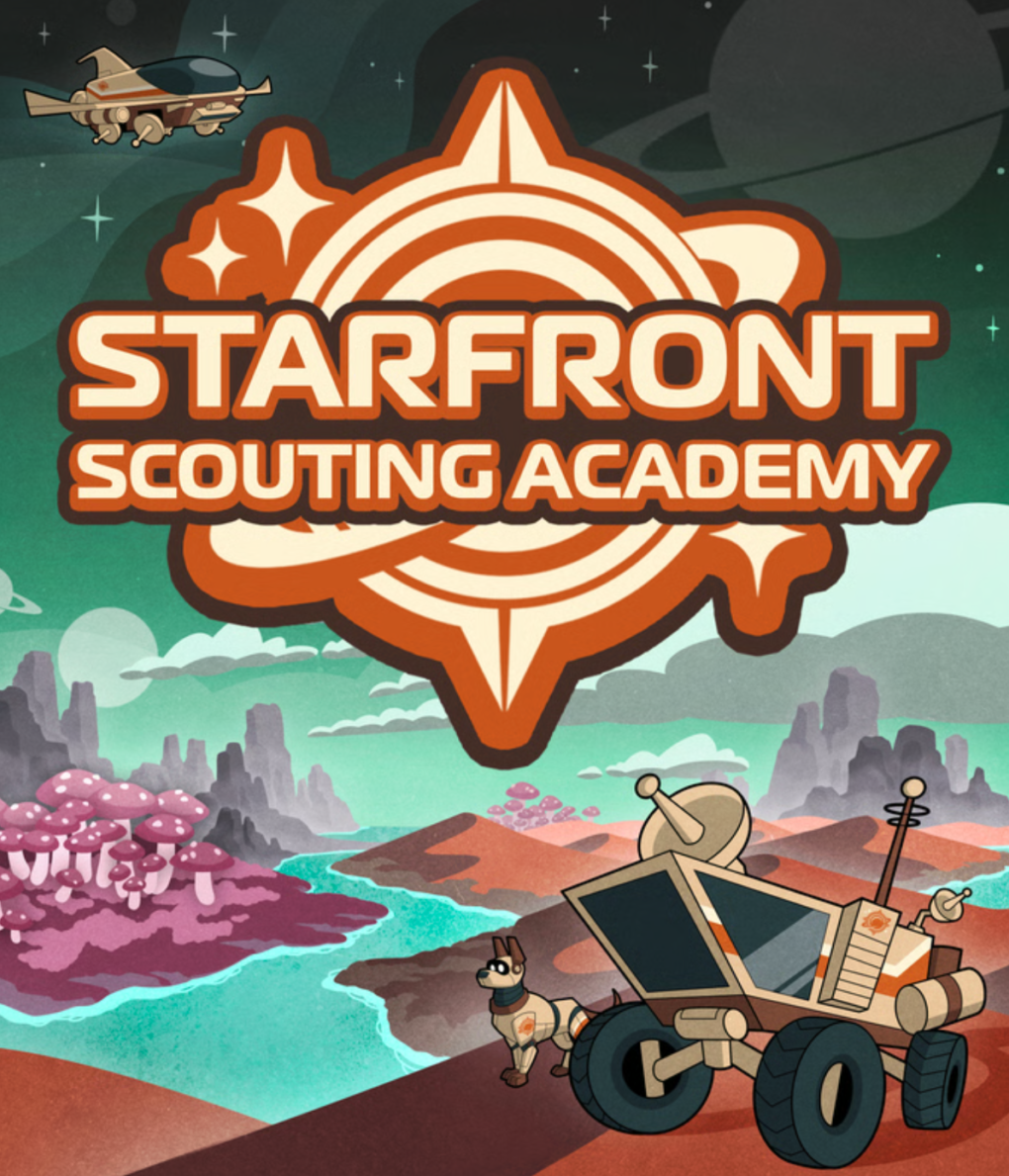I’ve been a big proponent of print-and-play games, and over the past year or two, dozens and dozens of these titles have hit Kickstarter, PNP Arcade, DicePen, and several other sites. It’s no wonder why – many of these games offer a short, fun game experience for less than half the price of a standard title. Yes, there’s a little extra effort that might go into it, and yes you may have to supply some of your own components. But for those who prioritize the gameplay experience and don’t need all the little fancy bits and pieces, print-and-play is the way to go.
Now, there are several different kinds of print and play, but my favorites are games that take place on entire sheets of paper. I prefer not to have to do much cutting, and I certainly don’t want to spend hours trying to properly align card backs and fronts. So these are usually my game of choice. There are plenty of options out there that scratch this itch, but most fall into the category of “roll dice, do thing”. There’s certainly not a problem with that, but I will say that it’s gotten a bit stale for me lately. Lots of them also involve going out and exploring different terrain types, marking the spaces that you visit. You’re usually looking at some form of area control, a bit of set collection, maybe a few other little things thrown in here and there.

Starfront Scouting Academy is the first title from Shiny Pigeon Printables, and it contains many of these elements. Plus, it’s in space, which I’m pretty tired of as a theme. So my fear was… is this game going to be like all others, or will it have some extra fun parts that will make it ready for launch? (Don’t worry, I groaned at that sentence, too.) Let’s find out!
I Need You to Be Clever, Bean
Starfront Scouting Academy, designed by Chris Backe, puts 1-6 players in the role of cadets facing their final exams. Their challenge: explore a toxic planet remotely using a variety of equipment. Your goal is to utilize your tools and your smarts to chart the planet in the most successful way and head to the top of your class!

Play works very simply – four dice of the same color are placed on the top, bottom, and sides of a shared Equipment Selection sheet. There’s also an extra die in the middle that represents SCOUT – a robo-dog that’s here to help you out. On a turn, you’ll select one or two of these dice to explore a particular terrain area, each of which uses the dice in different ways. For the dunes, you’ll take two dice and use the difference in their values. For the mountains, you’ll add 5 to one of the die values. You can only use dice that border that terrain type on the Equipment Selection sheet, so your options are somewhat limited.
Once you’ve made your choice, you’ll go over to the shared planet map sheet (there are 4 to choose from) and mark one of the spaces based on the value from your dice. You’ll then go to your individualized player sheet to mark the value and terrain type that you visited. You reroll the dice you use, place them on the Equipment Selection sheet, and then it’s the next player’s turn.
Play continues just like that until either a row, column, or full diagonal is completed, at which point scores are tallied. Players earn points in a variety of ways. The location values are split into three groups, and the two players with the most visits in a particular group will get some points. There are also points if you manage to visit a terrain type 4 or 5 times. Other little bonuses are also present, like having connected scout boxes or having your boxes in the line that finished the game.

There are also points available for completing six different patterns with your scout boxes on the planet map. Manage to be the first one to get the pattern completed and you’ll get even more points. Once everyone’s added up all their points, whoever has the most is the big winner!
She Just Wins… Thoroughly
Now as I said, I’m a bit tired of space games, and so I was hoping that the theme wouldn’t bring this down for me. For most games like this, the theme and everything rarely impact the way the game is played, and that’s pretty much the case for SSA. That said, I do like the flavor text and the presentation, and I feel like it goes really well with the artwork we have from Parker Simpson. It’s certainly space-themed, but it has a nice little “younger” twist to where it does feel like it’s intended for students. The full-color version looks really good, though I prefer a black and white printout as it’s easier to see what the players have marked on the sheets.
I played this game with my wife, and at two players, it made for a fun time that increased in competitiveness as it went along. We both started off doing our own thing. My wife went immediately after the patterns, while I tried to connect a bunch of my squares together. There’s so much space on the board for two players that you can easily stay out of each other’s way…. but what’s the fun in that? As the game went along, my wife was quickly racking up pattern bonuses, and I was getting a whole lot of nothing. So I started trying to take boxes away from her to keep her from getting more patterns. While this was successful for a bit, it only ended up making it so that I wasn’t getting many points for myself either. In the end, I did better than her in a few areas, but her focus on patterns and those big points for being the first one to finish them led to her having a clear victory.
If You Try and Lose, It Isn’t Your Fault
I will say that this game can be a bit more challenging for people that struggle with spatial reasoning in games. This is true for my wife, and there were times when she was taking several minutes on each turn. We quickly blew through the recommended time and got to a little over an hour, and we likely could’ve gone for 30 more minutes if my wife didn’t begin to focus on ending the game quickly before I could get more points. I’m sure as we play the game more, we’ll both go a bit quicker, but I could still see our games being closer to an hour than to 30 minutes.

In some cases, that would be a problem, as this game’s mechanics are pretty much the same from your first turn to your last. There are some bonuses you can unlock at certain levels when you visit the terrain types, and they do make for more interesting turns, but it’s still pretty much the same. That being said, I don’t think we ever got bored. As we started trying to get in each other’s way, that bit of competitiveness in us came out just the right amount, and it made for a good time.
I Will Not Be a Pawn in Your Game
I also played the game solo a few times, and I must say that I was incredibly impressed with how the rules have been manipulated to allow for this experience. When it’s just one player, they will take a turn as normal, but any dice that they do not use on a turn are utilized by a “storm simulator” to mark off spaces and make them unavailable. The use of direction and the values of the unused die is quite clever and not something I would’ve been able to envision myself.
That said, the solo mode is also REALLY hard. After playing with my wife, I thought that patterns would have to be the way to go, but that got blown up quickly. The way the simulator works, it’s always going to mark off spaces that are orthogonally adjacent to the one that you just selected. Therefore, patterns that involved having boxes in the same vertical or horizontal line led to lines that quickly filled up. My first game ended after less than 10 turns, and I had a miserable score. In my second game, I adjusted my strategy a bit, and I was certainly more successful but still fell far short of the top goal given in the manual. I do feel like there’s likely a strategy that could work, and I’m interested to keep trying it out.
Overall, I’m not sure that there’s anything about Starfront Scouting Academy that is completely unique or sets the standard for all print-and-play games going forward. However, it does what it does very well, and it’s a solid gameplay experience. This would be a very good family game for those with kids in the higher levels of elementary school, and I think it could also be good fun at the beginning of a gaming night before you get to your main gaming course. If you’ve been on the fence about backing a print-and-play campaign on Kickstarter, I would say that this is a very solid way to begin your journey into that realm.
You can check out the Kickstarter campaign for Starfront Scouting Academy RIGHT NOW!
A prototype of the game was provided for this coverage. Components and rules covered in this preview are not finalized. Read more about our preview policies at One Board Family.
Highs
- Nice artwork that fits well with the theme
- Fun interactivity that increases as the game progresses
- Very creative solo mode
Lows
- Nothing really stands out as unique in the genre
- Can be trouble for folks with analysis paralysis
Complexity

Time Commitment

Replayability


دیدگاهتان را بنویسید